 At a glance
At a glanceExpert's Rating
Pros
- Excellent CPU and gaming performance
- Flashy RGB lighting is manageable
- Great cooling
- Good value, even for the price
- An easy-to-install AI art creator
Cons
- Rear-mounted power port can be finicky
- Heavy and may not fit inside some backpacks
- Poor battery life, as expected
- Clunky utility software
- Loud fan noise at max performance settings
Our Verdict
MSI’s Raider GE78 HX delivers outstanding gaming performance and a solid overall experience, with an occasional rough edge that doesn’t mar its shine.
Best Prices Today: MSI Raider GE78 HX 14VIG-600US
The MSI Raider GE78 HX 14VIG arrives as the era of Intel’s 14th-gen Core HX chips dawns, delivering more than we expected, frankly.
The Raider is unabashedly a gamer’s laptop, with cascading RGB keys and a light bar that runs the width of the laptop. Boot up a game and the fan kicks in, hissing loudly. But the Raider also ships with a surprisingly decent keyboard, a very nice screen, and enough conveniences to consider using it full-time.
This 17-inch laptop certainly holds its own, and in many cases is the fastest gaming laptop we’ve seen to date. It has some quirks, though, one of which I found truly annoying.
Looking for more options? Check out PCWorld’s roundup of the best gaming laptops.
MSI Raider GE78 HX 14VIG: Basic features
Every version of the MSI Raider GE78 HX family is a 17-inch notebook. Other members of the GE78 HX family include the $2,699 MSI Raider GE78 HX VHG and the $2,399 MSI Raider GE78 HX VGG. The only difference between these models is the GPU: the HX VHG includes an RTX 4080 and the HX VGG includes a RTX 4070.
MSI also offers a Raider GE68 HX, a 16-inch notebook with a variety of display options, including a 4K 120Hz display. The GE78 also provides a maximum of 250W to the CPU and GPU, while the GE68 provides up to 240W.
Our review unit was sent to us by Intel as an engineering sample. There are two differences we noticed between our review unit and what’s on MSI’s website: Our review sample only has 32GB of RAM, and it runs Windows 11 Pro. We didn’t see any configuration options on any retailer websites, including MSI’s.
MSI did offer us a traditional retail review unit, which we initially declined because MSI provided us with a software update for the Intel sample that approximated the MSI retail version. It didn’t. Several apps didn’t work properly on the engineering sample, but did on the retail unit.
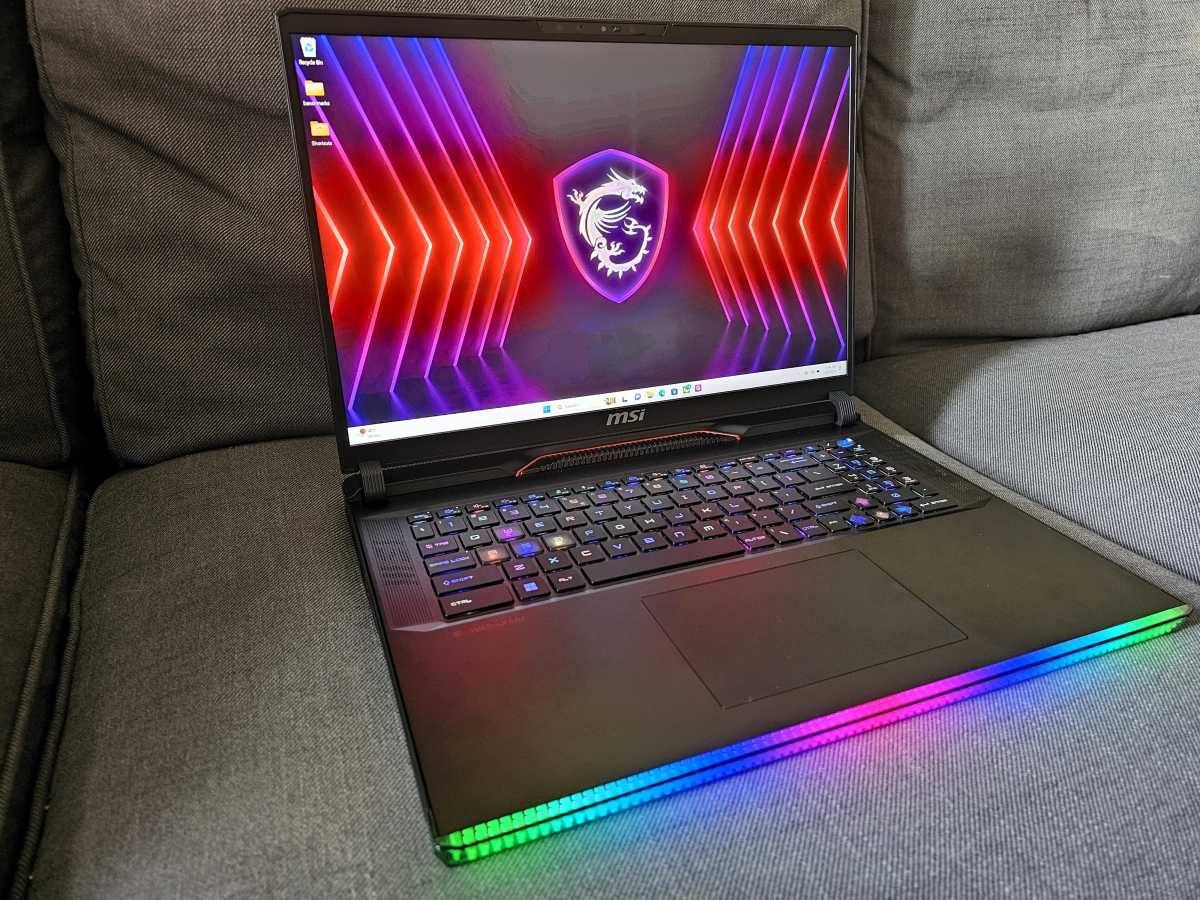
Mark Hachman / IDG
MSI Raider GE78 HX 14VIG: Specifications
- Display: 17-inch (2560×1600, 240Hz) IPS
- Processor: Core i9-14900HX
- Graphics: Iris Xe Graphics/Nvidia GeForce RTX 4090 (16GB GDDR6)
- Memory: 64GB DDR5-5600 (32GB as tested)
- Storage: 2TB NVMe Gen 4 SSD
- Ports: 3 USB-C (Thunderbolt 4, 10Gbps DisplayPort, 10Gbps DisplayPort+Power Delivery), 2 USB-A (1 10Gbps, 1 5Gbps), HDMI 2.1 (4K120), 1 SD Card 5.0 slot, 3.5mm jack, Kensington lock
- Camera: front-facing 1080p (Windows Hello) with shutter
- Battery: 95.0Wh (design)/94.4Wh (actual)
- Wired: Killer E3100G LAN (2.5Gbps)
- Wireless: WiFi 7 (Killer BE1750), Bluetooth 5.4
- Operating system: Windows 11 Home (Windows 11 Pro as tested)
- Dimensions (inches): 14.97x 11.73x 1.13in.
- Weight: 6.61 pounds
- Chassis: Plastic
- Colors: Black
- Price: $3,799.99
MSI Raider GE78 HX 14VIG: Design, build quality
A few years ago, the MSI Raider series weighed in at five pounds plus a bit more. Now, the GE68, with a 14th-gen chip inside, is 6.61 pounds total, which you will notice when hauling it out of the box. The 17-inch chassis also makes it a stretch, somewhat literally, to fit inside of a backpack, even one designed for gaming laptops.
Once powered up, though, MSI’s laptop immediately proclaims itself to be a gaming laptop. An LED light bar runs across the front edge of the 1-inch thick chassis, with individual, independent RGB lights running across the keys. The MSI logo on the rear of the display also cycles through various colors. You can, of course, turn these off, using the appropriate function key on the keyboard to do so.
Naturally, the Raider is well vented, with vents to either side and to the bottom of the chassis. MSI calls this technology Cooler Boost 5, with two fans and six heat pipes running internally. All of the hot air appears to be vented out the back and possibly on a narrow grill between the screen and keyboard. By default, the laptop ships in a state that combines a “MSI AI Engine” mode with an “MSI HybridGraphics” graphics setting to intelligently balance the needs of the CPU and GPU.
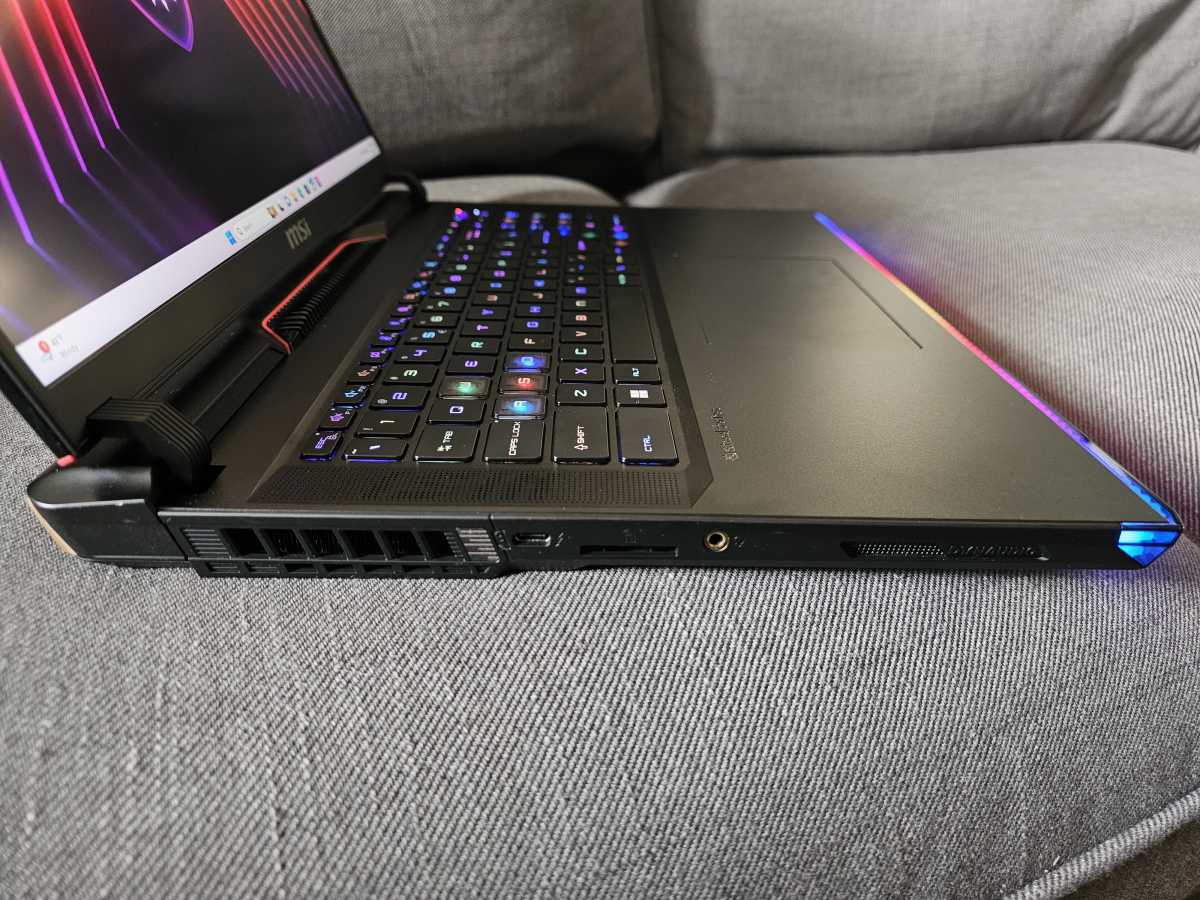
Mark Hachman / IDG
The fan didn’t kick in while browsing the Web, but in gaming it certainly does. The fans produce a very loud though neutral hiss, necessitating that you turn the volume up quite high or else use headphones.
The plastic construction is well put together, though there’s a bit of a wiggle to the display and a bit of keyboard flex if you press down firmly on the center keys. Two speakers are mounted on either side of the keyboard.
Perhaps the most annoying thing about the MSI Raider in my setup was the finicky power cable. While I admire MSI for building in a number of I/O ports, the Raider uses a rear-mounted rectangular power port that supplies the laptop with up to 330W of power. But the length of cord from the laptop to the power brick is short and heavy, enough that it often dislodged the power cable just enough to trigger pop-up safety warnings from MSI’s system utility. Sometimes the popups didn’t appear, and the laptop would slip quietly into battery mode.
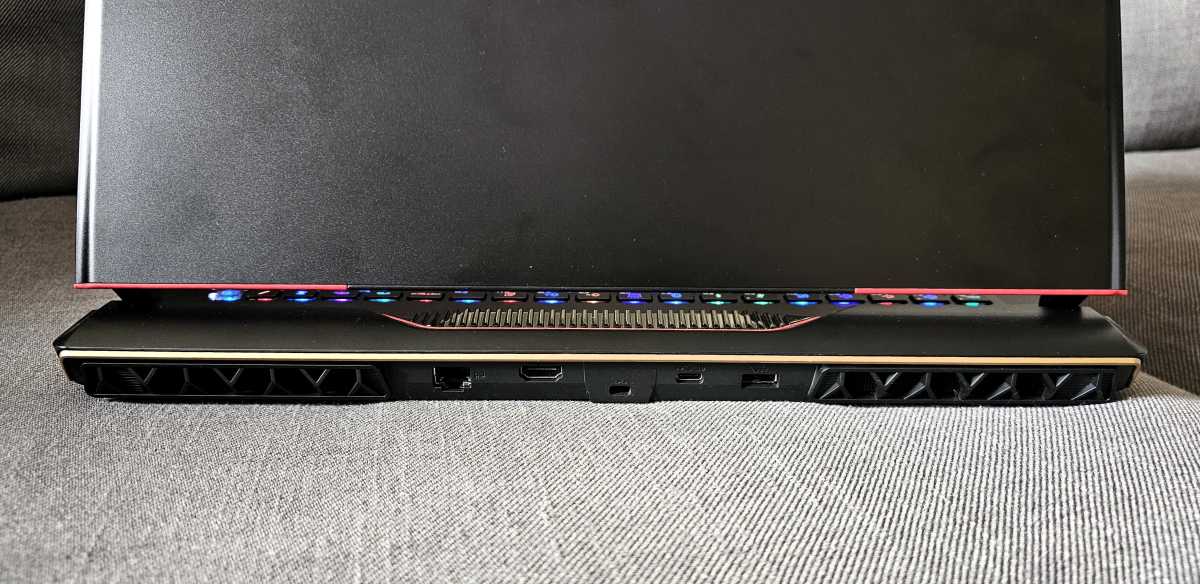
Mark Hachman / IDG
The constant warnings required me to remove and then reseat the power cable, or else the laptop would run on battery — no good for gaming! The only foolproof answer I found to that problem was to put the power brick on the same level as the laptop.
Yes, you might simply leave the laptop in place as essentially a desktop replacement. I was constantly moving it, checking small details and running benchmarks on a side table while I worked on the review. I can’t tell you how annoying it was to constantly have to reseat the power cable on the rear of the laptop.
I’ve never felt a such a strong affinity for side-mounted barrel chargers.
MSI Raider GE78 HX 14VIG: Display and ports
Otherwise, though, you’ll find that the MSI Raider GE78 HX 14VIG has more than enough room for multiple ports.
Those ports include three USB-C ports, noted above, which are marked to distinguish them from one another but with black-on-black labels that might require a flashlight to figure out which is which. Ditto for the two USB-A ports, which also differ in their capabilities. The SD card slot should prove useful for digital artists who capture images on an SD card. The only thing that the 2.5Gbps Ethernet port does, though, is make me anxious that I’m not taking advantage of the most powerful broadband offerings my ISP provides.
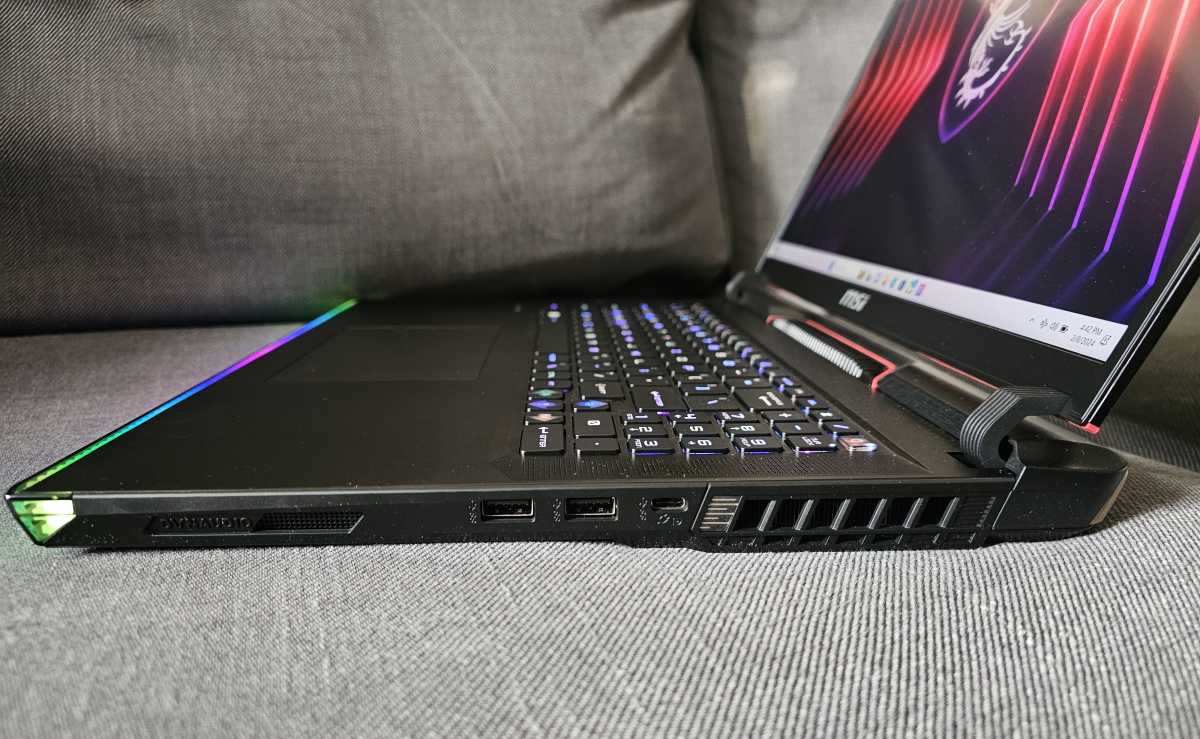
Mark Hachman / IDG
Note that this is a standard IPS display, rather than the OLED or miniLED displays rivals offer. Both of these other technologies provide better contrast, either by lighting pixels on a per-pixel basis (OLED) or by providing miniLED backlights, which divides up small portions of the screen into “zones” which can be entirely turned off to emulate the same effect. The Raider uses a standard LED backlight across the entire display. But it also avoids the “halo” effects that accompany miniLEDs, too.
We used our light meter to confirm that the Raider’s screen put out 463 nits of luminance in SDR mode. The laptop’s display is rated at HDR1000. Its contrast is 1,160:1, measured by our colorimeter.
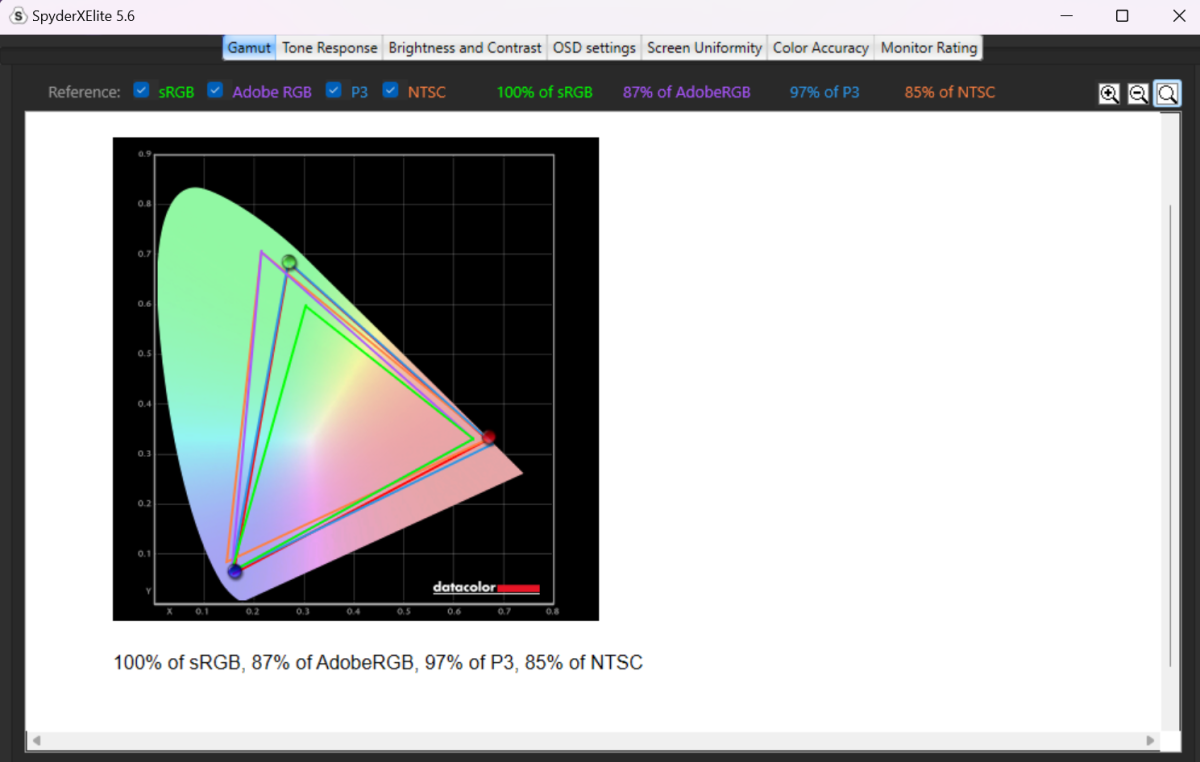
Mark Hachman / IDG
The Raider’s HDMI 2.1 port connected nicely to an external 4K120 display, providing an alternative to the native 1080p, 240Hz display inside the Raider. I love high-refresh-rate displays, but I appreciate the flexibility of connecting to a more ergonomic external screen.
It’s noteworthy, though, that the Raider has an option via its MSI settings menu to put the laptop into a mode where it uses the discrete graphics only, which triggers a switch on the motherboard to route the GPU directly to the display. This turns off the Thunderbolt ports. You’ll still have the option of running three displays (the internal screen, an external display via HDMI, and a third via one of the other USB-C ports) but it will take a bit of fiddling.
Inside the laptop is one of the first instantiations of Wi-Fi 7, along with Bluetooth 5.4.
MSI Raider GE78 HX 14VIG: Keyboard and LED
The Raider GE78 HX 14VIG includes a SteelSeries 99-key keyboard with per-key RGB lighting. Though MSI doesn’t use the mechanical keyboard on this model (you’ll have to buy an MSI Titan for that) I was surprised at how much I liked the feel of the keys. At 1.7mm, they don’t have quite as much travel as I’d prefer, but my fingers still bottomed out comfortably.
My biggest issue is only that the laptop is thick, with a 4.5-inch “chin” underneath the keys. That’s fine for resting your palms, but the keys are set back a bit further than I’d like. It also forces you to get used to the slightly raised keyboard deck.
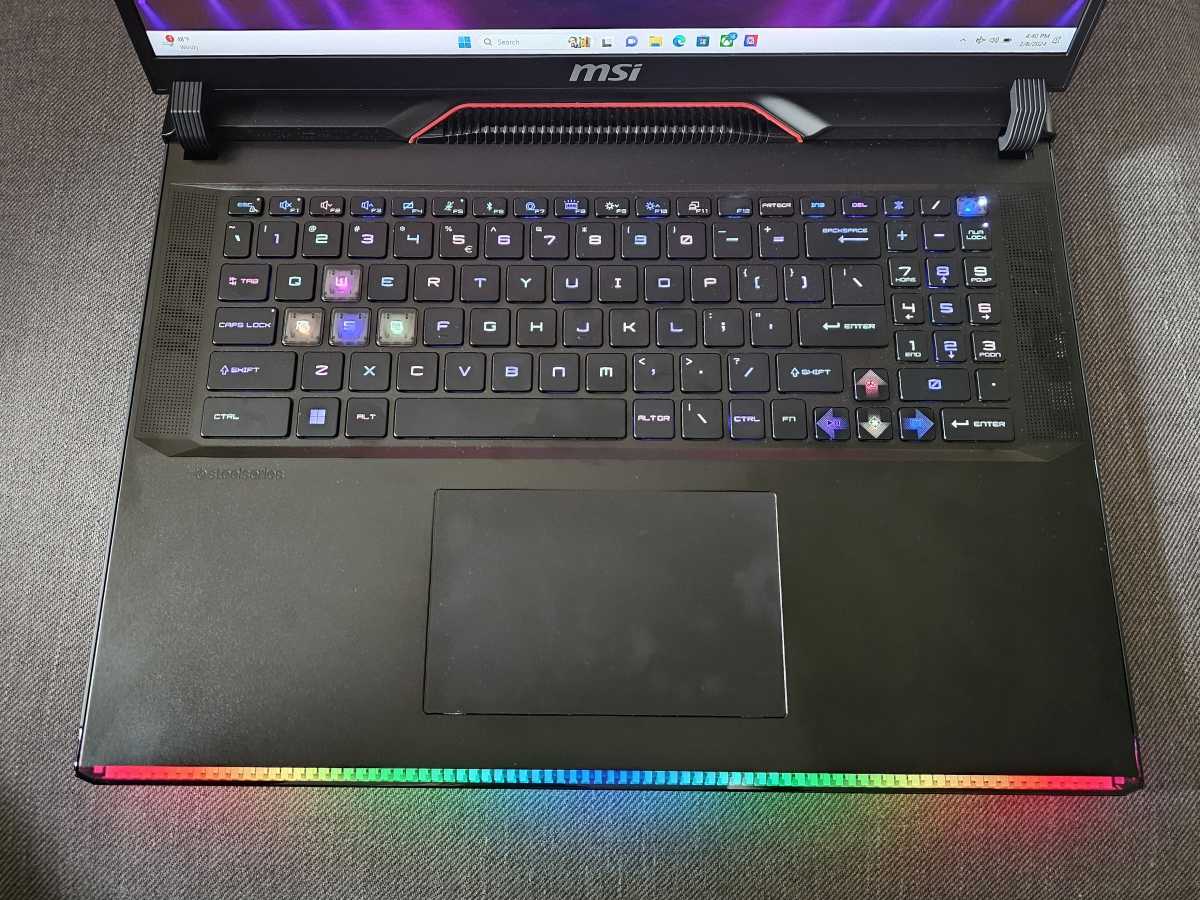
Mark Hachman / IDG
As a lefty, though, I’m sensitive to the number pad, which I use for gaming. MSI includes one, but it’s squished in, with smaller-than-expected keys. MSI does highlight its translucent, backlit WASD keys (yay, righties!) with their own distinct lighting. But the keyboard is bracketed by the two speakers to the left and right. I’d like to see what would happen if MSI extended the keyboard to the full width of the chassis, and moved the speakers closer to the user.
The keyboard backlight allows you to turn off the RGB backlighting entirely, and an additional tap can turn off the lightbar on the front edge, as well as the logo backlight. The retail unit allowed me to control both the light bar and the per-key lighting in a number of patterns and colors. I wasn’t able to control the lighting via the Windows 11 Dynamic Lighting feature, however, which is what Microsoft has promised.
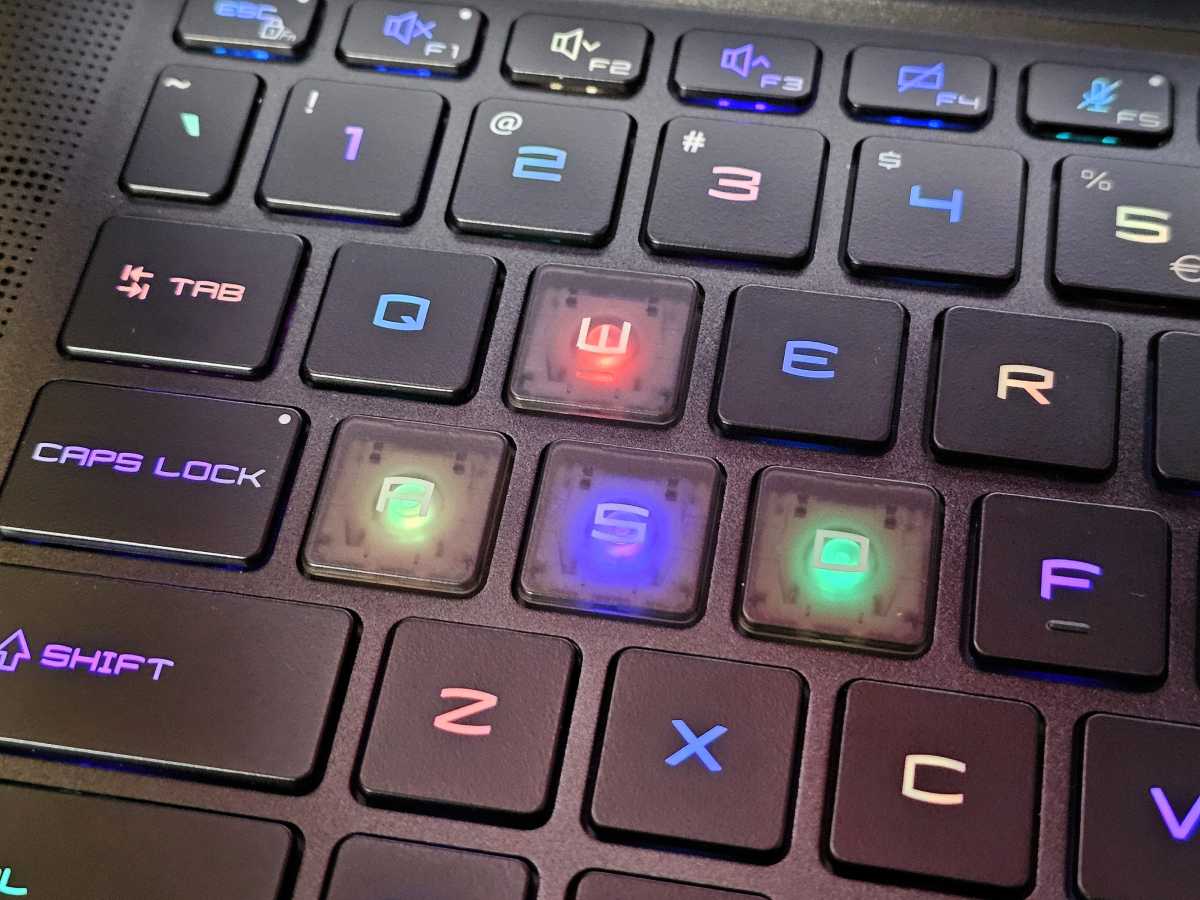
Mark Hachman / IDG
Note that the “Mystic Light” lightbar is similar if not identical to the 2023 edition, with discrete LED lamps hidden away behind a plastic shield that can be configured to use varying patterns. If you’re of a certain age, the words “Lite Brite” should help illustrate what MSI is going for. If they don’t mean anything to you, go back to playing Fortnite.
The overall RGB effect is a little over the top, a bit like an arcade or pachinko parlor. But the controls make it manageable for as long as you want to enable it.
Note that while there’s several levels of backlighting, there is no default “everything off” setting for long-term gaming while on battery. Something always remained on: the keyboard backlighting, or the light bar, or the “dragon” LED on the back of the laptop. You’ll need to go into the SteelSeries utility, turn off the light bar, then turn off the keyboard backlight.
Most trackpads I test perform well, and the Raider was no exception. The trackpad was silky smooth and clickable all the way to the top, though you’ll need more force near the top of the screen.
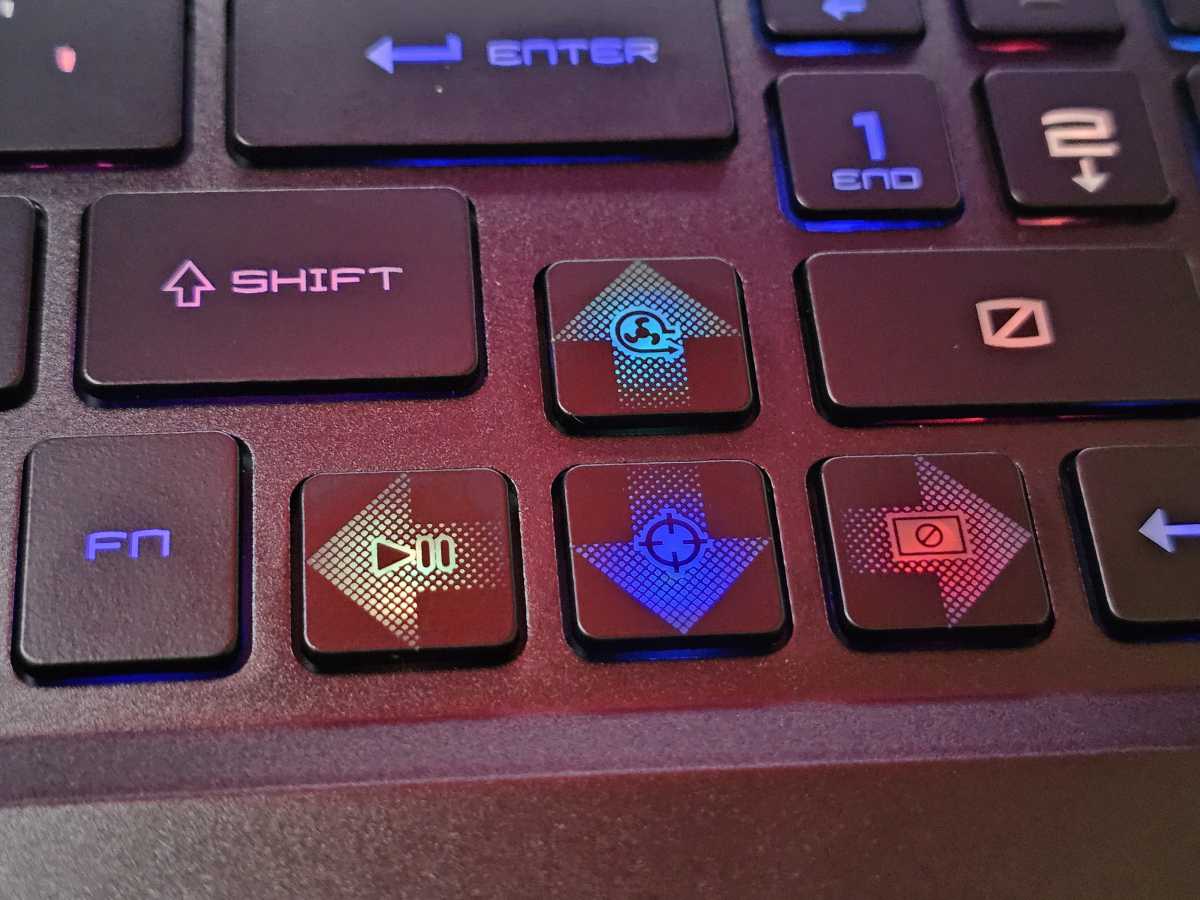
Mark Hachman / IDG
MSI Raider GE78 HX 14VIG: Audio and webcam
MSI’s Raider GE78 HX 14VIG is powered by its Dynaudio system and Nahimic’s audio enhancement over the top of that. Oddly, I wasn’t able to enable the Nahimic software using the Windows audio picker, though I was able to test it out using the built-in Nahimic app.
This is why I requested a retail unit. On our engineering sample, the audio was pretty flat, with no surround-sound except through the canned Nahimic demo. The retail version of the Raider delivered what I expected, a richer audio experience from the lows to the highs. This isn’t going to blow away audiophiles at all, but the sound is pretty acceptable, and better than most notebooks I’ve heard. I wasn’t convinced that the Nahimic audio actually worked; now I am.
As noted above, though, the Raider’s fans are loud. You’ll likely play with headphones or with the laptop’s volume cranked high. Using the MSI AI Engine setting and playing back video, however, the fans barely turned on, if at all. That made playing back a movie on Netflix or listening to a song or YouTube video a pleasant experience.

Mark Hachman / IDG
The webcam ships with a slidable privacy shutter, a nice touch. But the 1080p webcam was a touch grainier than I’d like, though not too shabby. None of your friends may care about you looking your best, but there’s definitely room for improvement. It does offer Windows Hello capabilities, though, which not every webcam does.
The webcam mic is decidedly average. You’ll sound flat, and the laptop didn’t do a great job of filtering out background noises, which means that your friends may complain while you’re chatting on Discord.
MSI Raider GE78 HX 14VIG: Apps
Because our initial review unit was an engineering sample, we asked MSI for links to the current versions of the installed software, which the company provided.
The MSI Center is the laptop’s central utility, with downloadable modules for managing the display output (True Color) to apps that can intelligently search through a folder full of images. It’s here you’ll find its hardware monitor, too. Again, it’s a good thing I asked for the retail unit, as the MSI Center was horrifically laggy on the sample, and quite smooth on the retail unit.
MSI’s latest version of MSI Engine ships with what it calls the “MSI AI Engine”, with automatic adjustments to the display, audio, and performance based upon the scenario. I couldn’t detect much of a difference between the video and audio depending upon the scenario, but the default “MSI AI Engine” basically replaces the “Balanced” setting in the performance tab — at least on the games I tried. You might consider playing around with these settings further (either Silent mode or Smart Battery) if you’re using the laptop as a productivity machine.
One nice touch that more manufacturers should consider is MSI AI Artist, a custom AI art application that can be optionally installed. Although the app is in beta, it appears that it can be downloaded by any user, provided that they meet the minimum hardware specifications (a 13th-gen Core chip plus an Nvidia RTX 4050 or above).
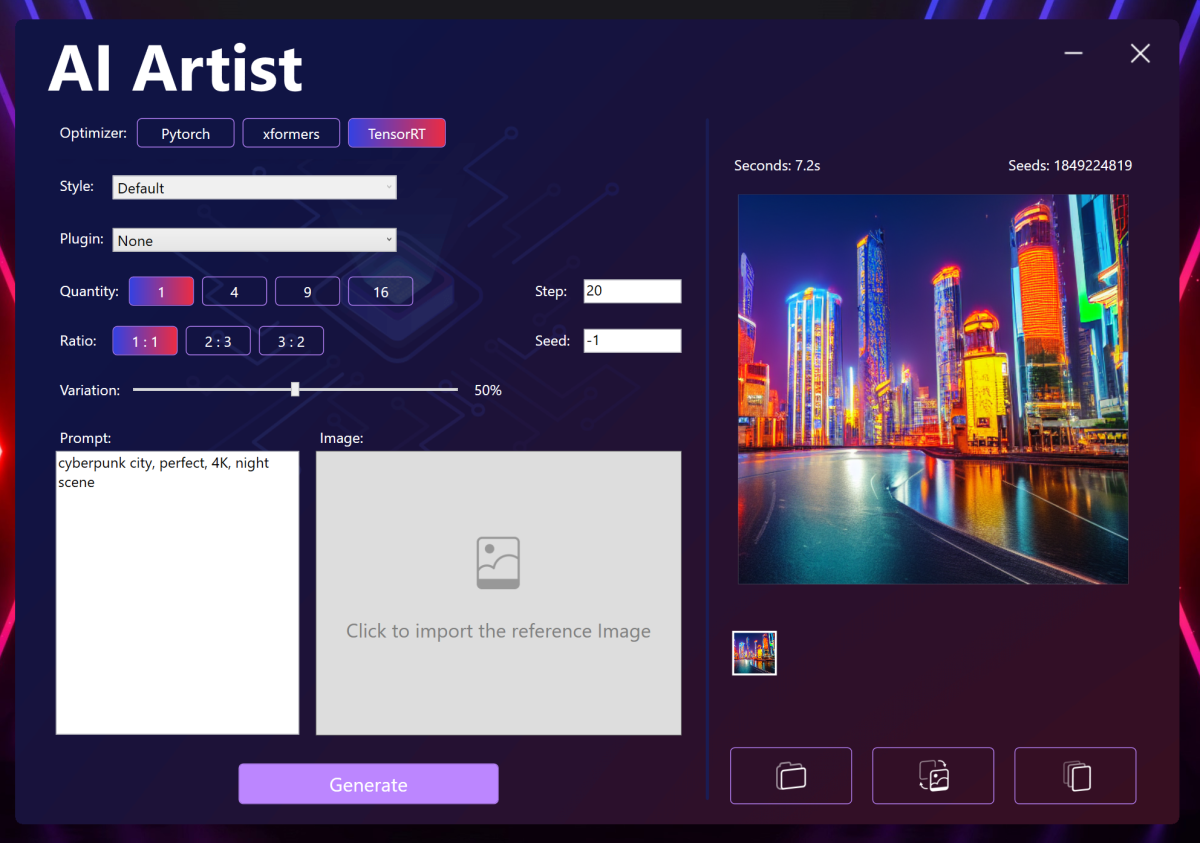
Mark Hachman / IDG
While I could (and did) download similar AI art applications that produced better results, MSI’s app is still a one-click executable with quite a lot of configurability. It just took over 30 minutes to install, as it needed to download the models in the background. It also took close to a minute to actually launch. The results were just fair, compared to other AI art programs I’ve tried, but there do at least appear to be options to download additional configuration files.
Since the art runs locally on your machine, MSI doesn’t care what you draw. NSFW and celebrity art worked just fine, but, weirdly, the app had a tough time with “normal” art like a dog eating a burrito.
MSI Raider GE78 HX 14VIG: Upgradability
We didn’t open up the Raider, but MSI says that the laptop includes two x4 M.2 slots, one using PCIe4, and the other PCIe5. There are two DDR5 DRAM slots, for a maximum of 96GB.
MSI Raider GE78 HX 14VIG: Performance
Normally, we test laptops using the default configuration in which we receive it, which usually means a “Balanced” setting somewhere between quieter fan noise and higher performance. Our review model came with a “Smart Auto” setting, an “AI” setting which tries to determine what you’re using the laptop for and adjusts the performance accordingly. (After updating the MSI Center app, that setting became the “MSI AI Engine.”)
Put simply, the “Smart Auto” setting and the “Balanced” setting produced almost identical results, at least in games. MSI also allows you the option of specifically setting the graphics mode to the “Hybrid” setting (the default), to only use the integrated graphics, or to switch entirely to the discrete graphics for everything. The latter quickly ramps up the fan noise, as the discrete graphics are being used for everything.
These trigger a couple of quirks. First, MSI placed a “MUX switch” in the motherboard circuit so the GPU can be rerouted to the panel directly, according to Intel. Second, turning this configuration on essentially turns off the ability to route the display through the Thunderbolt port to an external monitor — not a huge deal, especially with an already integrated HDMI port and a high-refresh rate display already built in. (In this scenario, the HDMI port will drive a second display, and you can run a third display via a USB-C dongle, albeit at 30Hz.)
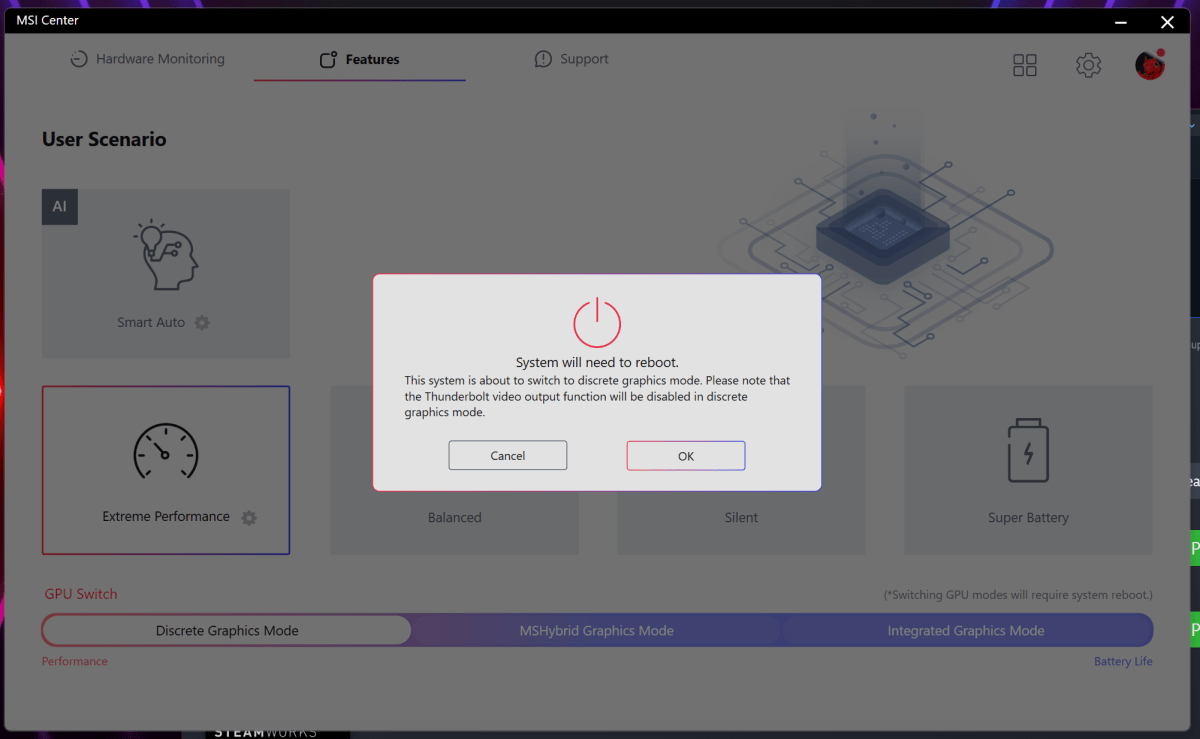
Mark Hachman / IDG
Note that you can set this laptop to silent mode if you want to use it for work without worrying about the fan kicking in.
I used MSI’s “Smart Auto”/”MSI AI Engine” setting for virtually all of my testing. In some cases, namely gaming, I tested using the laptop’s High Performance setting to provide additional results. The MSI Overboost Ultra technology delivers 250W, 175W to the GPU (150W standard plus 25W) with Dynamic Boost 2.0 and 75W to the CPU, running all 8 P-cores over 5.2GHz. Some of my testing (not shown in the benchmarks) actually produced worse performance with the laptop in its high performance mode, possibly because it didn’t cool well between tests.
I had some idea of what to expect from the Core i9-14900HX inside the MSI Raider GE78 HX 14VIG because of our earlier 14th-gen Core HX platform testing. Those tests revealed, unsurprisingly, that the 14th-gen “Raptor Lake Refresh” architecture was nearly identical to the 13th-gen “Raptor Lake” architecture. Still, those tests focused solely on the CPU, and we dialed up the performance to the maximum for the most aggressive comparison.
Still, with Intel’s Core i9-14900HX, a 24-core, 32-thread processor with eight performance cores and 16 efficient cores under the hood, you would expect the performance to be top-notch. The $3,799 Raider GE78 also offered me a chance to go head-to-head with the $3,899 Asus ROG Strix Scar 18 (2024) which features a basically an identical 14th-gen Core HX configuration. I also tested with a bevy of 13th-gen Core gaming laptops: the 17-inch, $3,599 Acer Predator Triton 17X; the 16-inch, $2,999 Alienware X16; the 18-inch, $4,499 Razer Blade 18; and last year’s beast, the 17-inch $5,299 MSI Titan GT77 HX 13V.
Keep in mind that the number of pixels each laptop is pushing makes a difference; the Titan, for example, is being asked to power 1.19 billion pixels per second — a function of its resolution multiplied by the screen’s refresh rate — about 22 percent more than the Raider. And remember, we were issued an engineering sample; the actual Raider includes 64GB of RAM. That might not affect these benchmarks, but you’ll be able to multitask well with that much extra memory.
We begin with PCMark 10, which tries to reproduce the gamut of applications that could run on the top of the Raider GE78, from word processing, video calls, Web browsing and CAD work. The result is rather average, compared to the other gaming laptops we’ve tried.
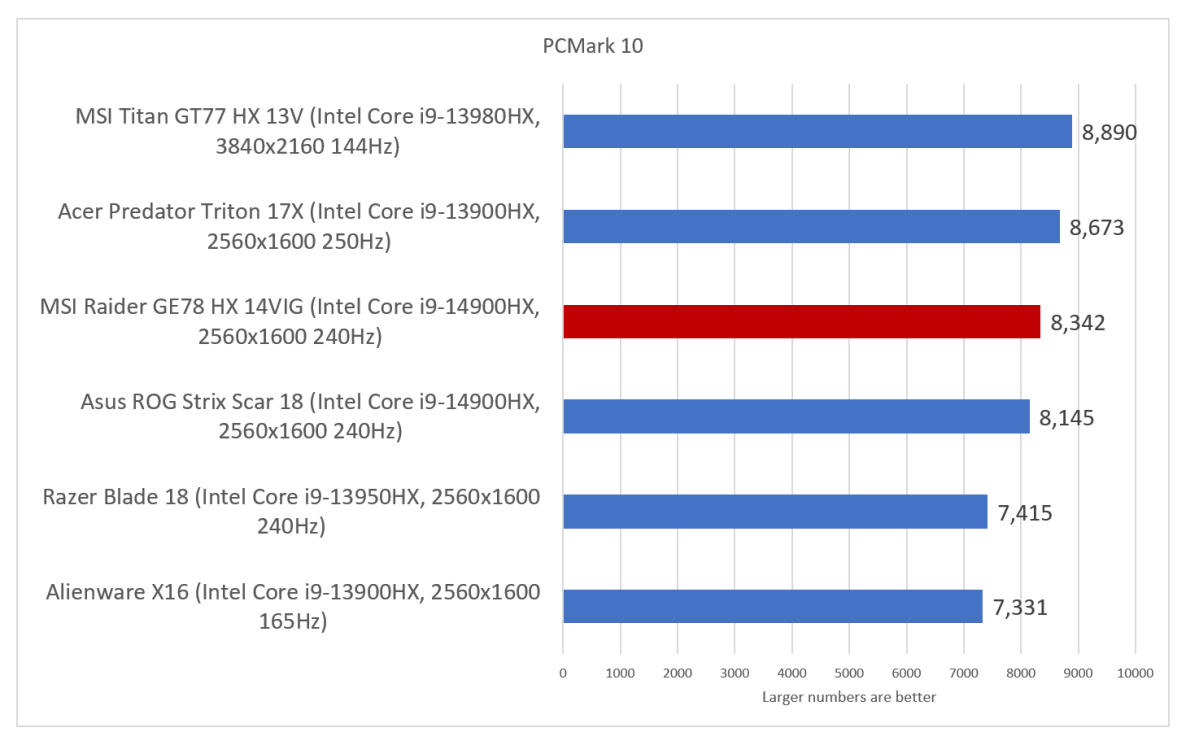
Mark Hachman / IDG
We also use Cinebench R20 as a way to measure the Raider’s performance across heavily multithreaded applications. Here, the Raider tops the Strix in both multithreaded performance as well as single-threaded results (not shown), where the Raider outperformed it, 841 to 820.
Cinebench is a good, synthetic benchmark for applications that we don’t specifically test. Put simply, any piece of software specifically designed to run on multicore chips will thrive on the MSI Raider.
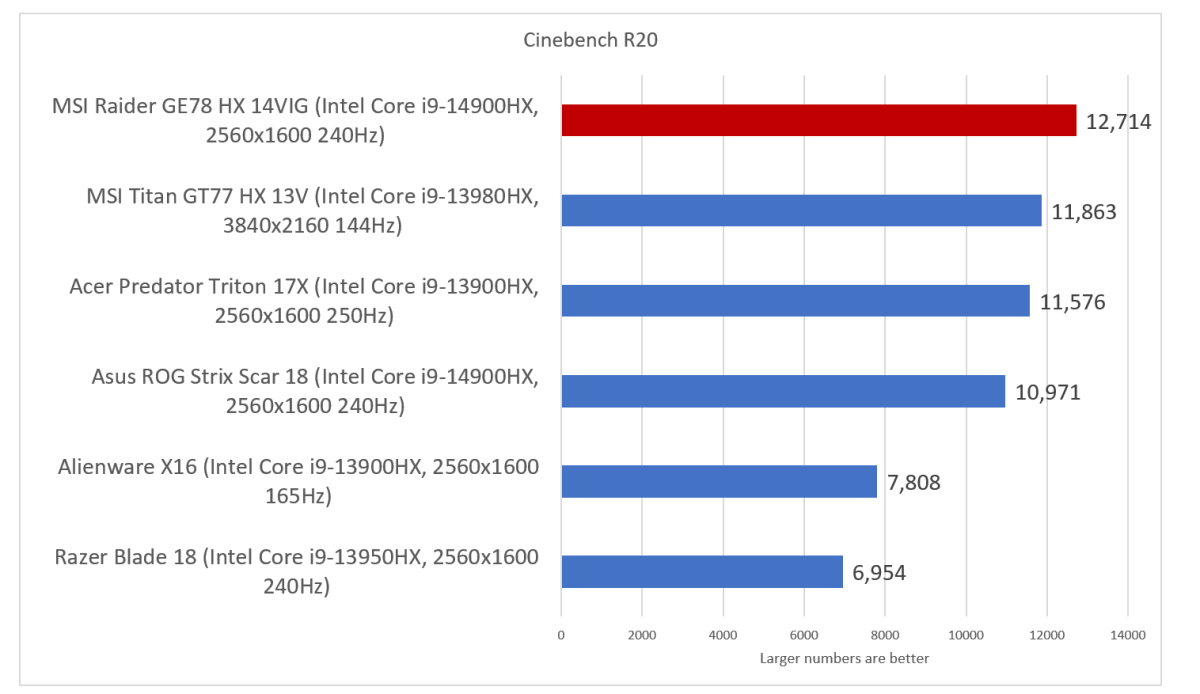
Mark Hachman / IDG
We use Handbrake as a way to test how well the laptop holds up under load, transcoding a Hollywood movie and measuring the time in which the transcoding requires. Modern gaming laptops like the Raider GE78 can accomplish this in just a dozen minutes or so. I recall this test taking hours on eight-gen Core chips.
I like to also test the laptop using the Cinebench R23 benchmark, which allows for both a single run as well as looping the benchmark over and over for ten minutes straight. The closer the short single run is to the looped ten-minute run, the more assured you can be that the laptop’s performance will persist over a long gaming session.
A single run produced a score of 33,089 while the looped benchmark was 30,993, a 6 percent drop. That’s a very good result and is a testament to the Raider GE78’s cooling.
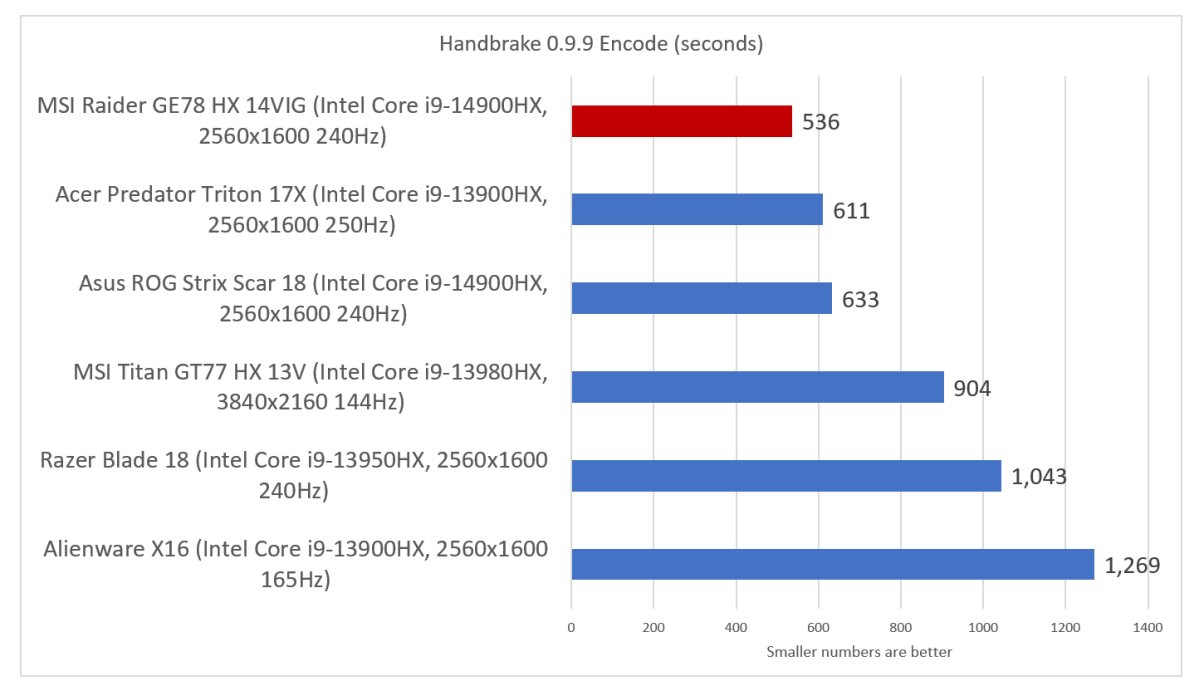
Mark Hachman / IDG
We use one synthesized test to measure the graphics output of the laptop and that’s 3DMark, specifically the Time Spy benchmark. Since most of the gaming laptops we’ve tested from this generation and the last have contained an RTX 4080 or RTX 4090, we’d expect the results to be relatively uniform. And they are.
We’re moving into the segment that most people buy the Raider for… gaming!

Mark Hachman / IDG
I also checked to see how the laptop would handle a prolonged gaming session. I did that in two different ways. First, I used a 3DMark Time Spy stress test, looping a benchmark repeatedly. 3DMark measures the frame rate for each loop. Again, if the performance holds up over several loops, then you know you’ll be able to play for a long time with consistent performance.
The Raider GE78 passed this stress test as well, surviving 20 loops while maintaining 99.3 percent of the frame rate. That’s solid work on MSI’s part.
Gaming, though, is why we’re here. We use several fairly recent games as measures of how the laptop performs. Our first is Rise of the Tomb Raider. It’s one of the only tests where the MSI Raider does poorly, comparatively. Most people use 90 frames per second as a good indicator of performance.
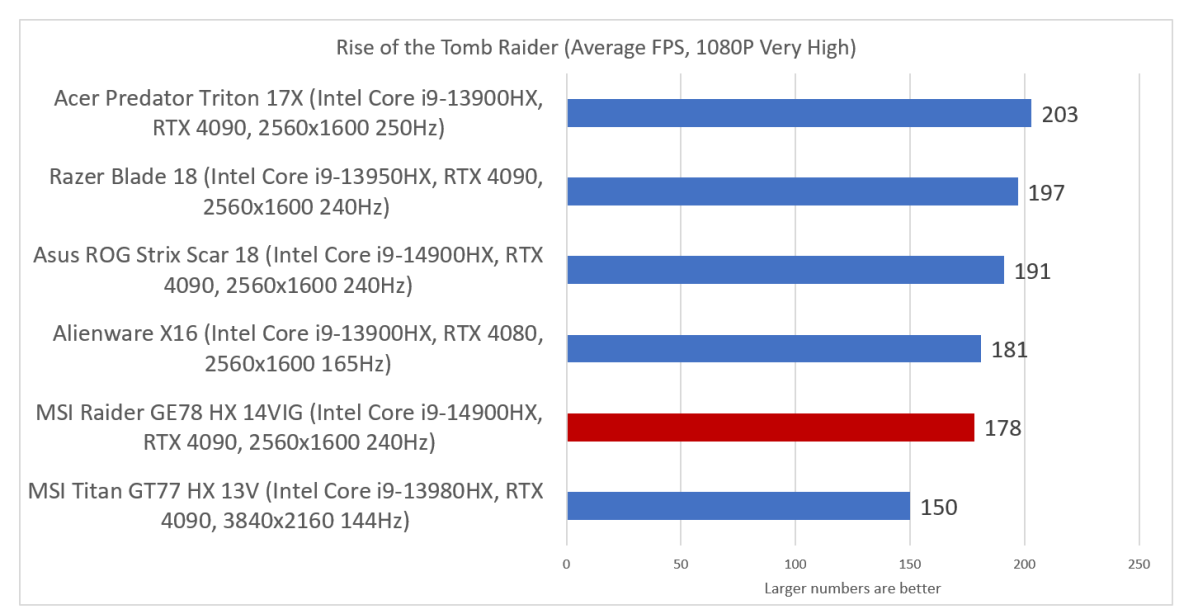
Mark Hachman / IDG
Interestingly, there was a sharp difference between the “Smart AI” setting and when I put the laptop into its performance mode, with discrete graphics on all of the time. Frame rates soared to 242 fps. (On “Balanced” mode, the laptop scored 184 fps.)
I also ran the game’s sequel, Shadow of the Tomb Raider, which uses an enhanced version of the engine used on Rise of the Tomb Raider.
Again, we expected a close race between both the 13th- and 14th-gen Core chips in our gaming notebooks and that’s what we received. But the Raider also solved whatever problems plagued its Rise benchmark. On maximum performance settings, the Raider GE78 hit 229 fps and 205 fps on Balanced.
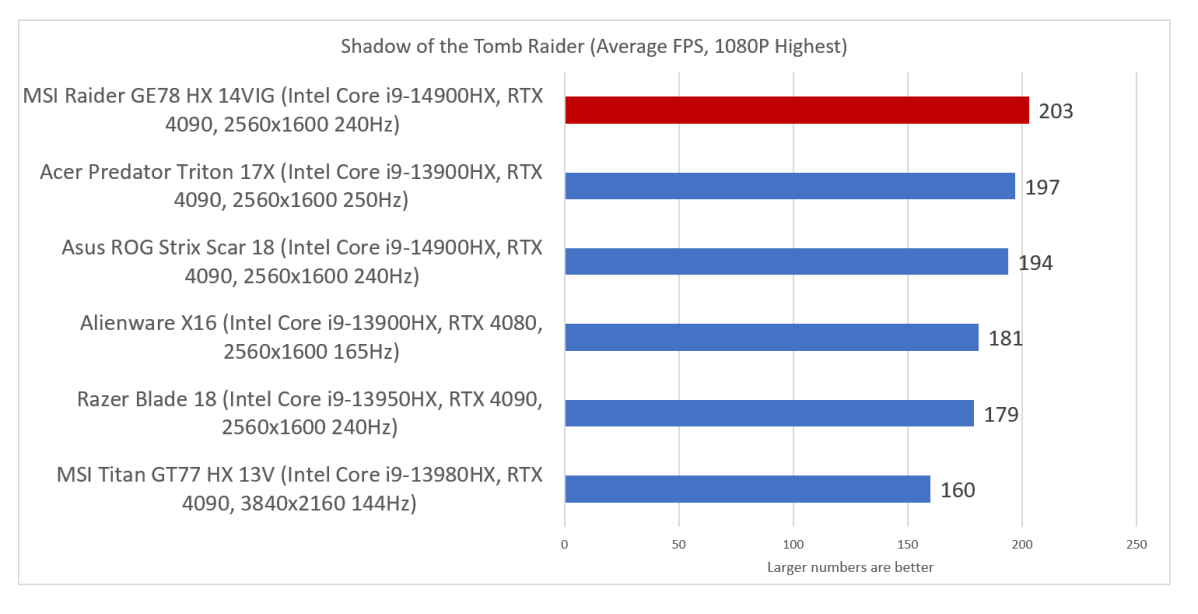
Mark Hachman / IDG
The third game I tested is Metro: Exodus, where MSI’s Raider returns to the top of the heap. This represents an average FPS score, so you’ll see some dips below this level. Here, the Raider GE78 showed almost no difference between its Smart Auto settings and maximum performance. At max settings within the MSI system utility, performance only climbed to 93 fps. At Balanced settings, the laptop reported 80 fps. Maybe MSI’s “AI” was kicking in?
In general, though, this supports MSI’s argument that the Raider GE78 is a top-flight gaming machine.
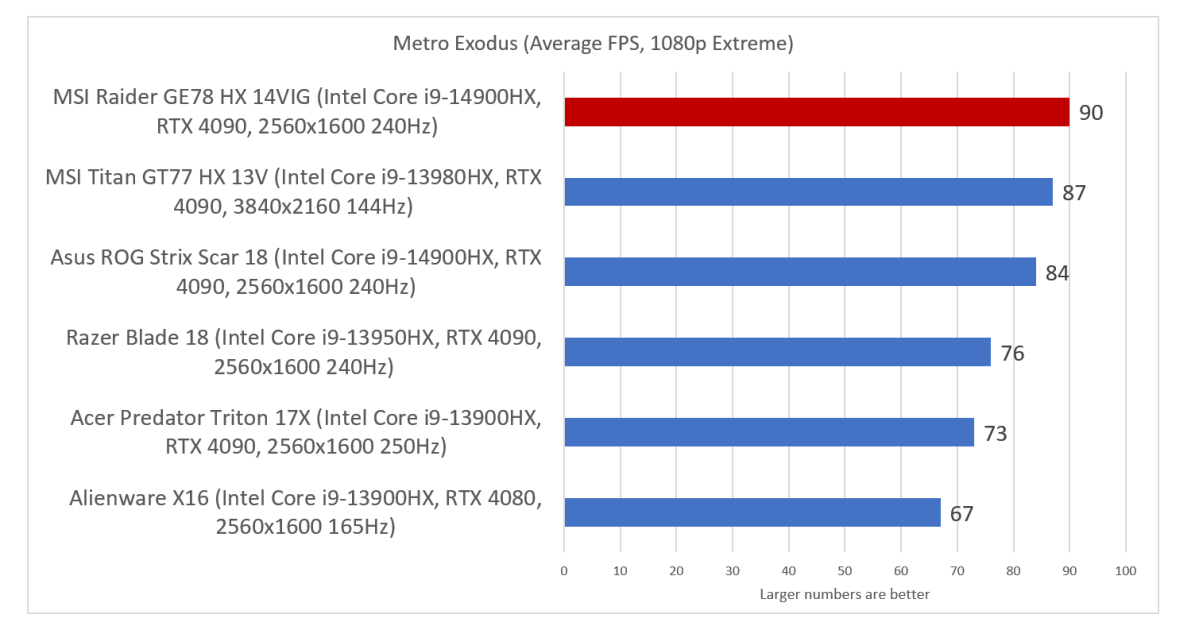
Mark Hachman / IDG
Finally, we look at battery life. Inside the MSI Raider GE78 HX is a 99.9Wh battery, the maximum allowed by the U.S. TSA aboard an airplane. We set the screen to a fixed brightness, measured in nits, then looped a 4K video over and over until the laptop ran out of power. We never expect much out of a gaming laptop and we weren’t disappointed! All that horsepower works against the laptop, even after turning off all of the RGB lighting.
In all, there was a bit too much diversity in our test results for us to be happy with. Normally our results are consistent. Our highest result was 359 minutes and our low was 195. The others were somewhere in between.
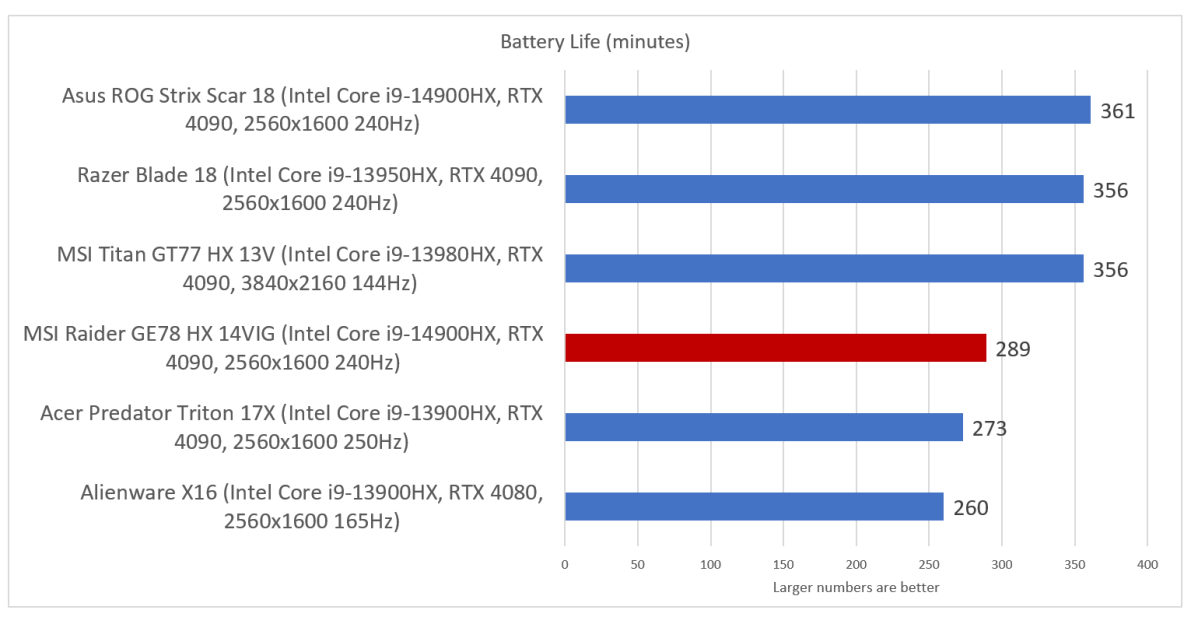
Mark Hachman / IDG
And how much battery life can you get if you simply game the entire time? Not much. We looped the 3DMark Time Spy benchmark over and over, and only received about 92 minutes of operation before it conked out.
MSI Raider GE78 HX 14VIG: Is it worth buying?
We’re early into the 14th generation of Intel Core HX notebooks, but our benchmarks showed a clear delineation between 13th- and 14th-gen gaming notebooks, more than I expected. So far, we have two 14th-gen notebooks to compare between, the Asus ROG Strix and the MSI Raider GE78, and the latter is the clear winner. Add 32GB to it (and boy, I was tempted to ask for a full-fledged review unit, just to see what it could do) and it will shine.
MSI’s 14th-gen GE78 HX 14VIG excels as a gaming laptop, with a number of admirable features that try hard to convince you to use it as an all-around machine.
Gamers will care solely about the gaming performance, and the MSI Raider generally soars to the top of the heap. But I liked the Raider’s keyboard, even if the laptop’s size pushes it to the rear. A 1080p webcam? Not the best, but it’s a nice touch. (Improve that a bit, and the Raider really would be a laptop I’d consider using for both work and play, provided I didn’t have to take it anywhere.) The RGB? Maybe a bit cartoony, but still fun. And give credit for MSI’s AI Artist: there’s room for improvement there, too, but it’s a worthwhile introduction to AI art.
Battery life, well, stinks — no surprise to any gamer. As someone who reviews Thunderbolt docks for PCWorld, shutting off the Thunderbolt port while in a dedicated discrete graphics mode feels like a slight stumble. The Raider’s fan is noisy, though neutral. The power port, too, is hit and miss. When I treated the Raider as a laptop, moving it around, the finicky power cable was a true annoyance. Thinking that your laptop is plugged in and discovering that it’s running on battery is no fun at all. If treated as a desktop replacement and left in one place, that issue fades away.
MSI’s Raider GE78 HX 14VIG certainly achieves what MSI intended: top-notch gaming performance with a surprisingly good holistic experience as a general laptop, too. We even took a look at an upcoming MSI Titan review — the true behemoth — and it looks like the Raider outperforms it, too. Excellent work, MSI.




